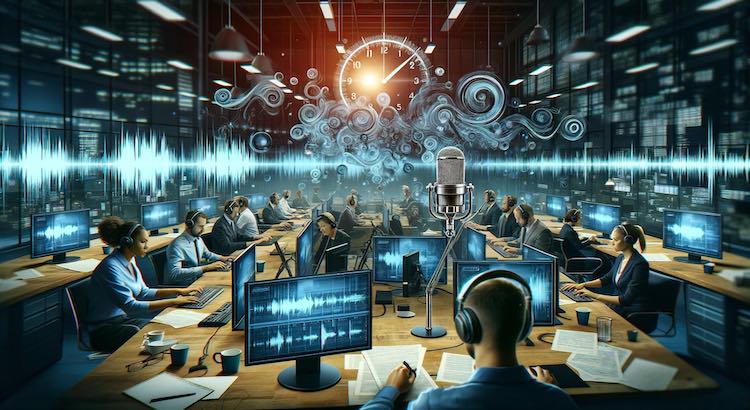How Audio Transcription Helped Break a Major News Story: A Case Study
In today's media landscape, news moves at the speed of light. Journalists need to process large volumes of audio quickly and accurately. The right tools can spell the difference between leading with a breaking story and missing the news cycle altogether. Audio transcription is one of these essential tools, turning spoken words into text that journalists can search, reference, and quote instantly.
Background: The Breaking News Event
This case study looks at a real situation where a whistleblower leaked hours of audio recordings from high-level meetings. The recordings contained major revelations. For journalists, these conversations held the keys to a public-interest story. But there was a big problem—the sheer volume and length of the recordings.
- Journalists received multiple hours of compelling audio.
- The recordings had many speakers and some spoke with strong accents.
- Conversations included industry jargon and technical details.
Listening to and analyzing hours of audio is time-consuming. Journalists needed a solution to pull out facts, quotes, and key evidence quickly.
Challenge: Time Pressure and Complexity
The top issue was time. Newsrooms wanted to release details before their competitors. Manual transcription by staff would take days or weeks, much longer than they could afford.
- Manual transcription for one hour of audio often takes up to 4-6 hours (Rev, 2022).
- Accuracy was crucial; even small errors could distort the facts.
- Audio clarity varied, making the process even harder.
These challenges led the newsroom to seek professional help.
Solution: Employing Professional Audio Transcription Services
The newsroom turned to a leading audio transcription provider for fast and accurate results. Services like GoTranscript's transcription services are built for situations exactly like this.
- Automated transcription tools made initial passes at converting speech to text.
- Human transcribers checked and corrected errors, clarified jargon, and ensured high accuracy—key for journalism.
- Speaker identification and time stamps made searching and organizing the text simple.
How the Transcription Process Worked
- Upload and Analysis: Journalists uploaded audio files to the provider's encrypted platform, ensuring security.
- Automated Transcription: Advanced systems created quick drafts of the conversations. These drafts were ready within minutes or hours (GoTranscript, 2023).
- Human Review: Transcription experts listened to the files. They double-checked accuracy, spotted tricky parts, and labeled multiple speakers.
- Final Delivery: Completed, polished transcripts came back, ready for use by the newsroom. Files included time stamps and speaker tags for easy quoting.
Outcome: Fast, Reliable Reporting
Because of the transcripts, reporters could scan hours of conversation in minutes. They searched for keywords, pulled key quotes, and found hidden details.
- The newsroom published the first major articles based on the transcripts within 24 hours.
- The story made national headlines and prompted official investigations.
- Transcripts gave reporters confidence to quote meetings verbatim, reinforcing the facts.
Later fact checks and follow-up stories drew on the thoroughly checked transcripts. The verbatim text became a reliable reference for future coverage.
Why Transcription Matters in Modern Journalism
Audio transcription services give newsrooms a critical edge. In a 2022 survey, 76% of journalists said tools that help them process information quickly are "essential" to their jobs (Poynter, 2022). Without fast, accurate transcription:
- Important statements can be missed or misheard.
- Editors lose time, risking the story getting out first elsewhere.
- Quotes may be less reliable, which can damage credibility.
Professional services can handle poor audio quality and industry-specific terminology. Many also offer automated transcription options for quick jobs, plus transcription proofreading to double-check work.
Other Features That Support Journalists
- Multilingual transcription: Some stories involve non-English sources. Text translation and audio translation services make these interviews accessible.
- Closed captioning and subtitling: For video segments, closed caption services and subtitling ensure accessibility for all audiences.
- Affordable options: Journalists can check transcription pricing and captioning services pricing to fit their budgets.
Step-by-Step: How to Order a Transcription
Ordering a transcription is simple, even during a breaking news rush. Here’s how journalists do it:
- Start by uploading audio or video files directly to a provider like GoTranscript using the secure order transcription portal.
- Choose the service type: Automated, human, or a mix for the balance of speed and accuracy.
- Specify special needs: Note multiple speakers, accents, or industry-specific terms.
- Review and download the finished transcript when ready—typically within hours.
If closed captions are needed for broadcasting video, journalists can also order captions through the same process, making video content accessible fast.
Conclusion: The Essential Role of Transcription in the Newsroom
This case study shows how audio transcription can turn raw, chaotic recordings into a clear, actionable resource. With the right tools, journalists broke a story fast and kept the facts accurate. This is just one example of how transcription services support trustworthy, timely reporting.
GoTranscript offers a full suite of AI transcription subscriptions, human transcription, translation, closed captioning, and proofreading. These solutions help newsrooms everywhere move quickly, work accurately, and lead the coverage when important stories break.



















 Verified Order
Verified Order